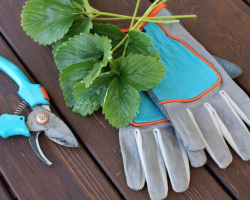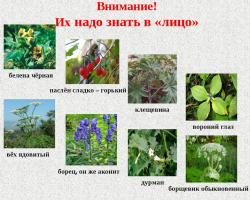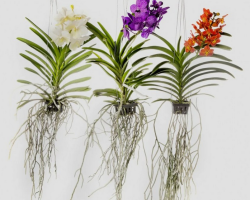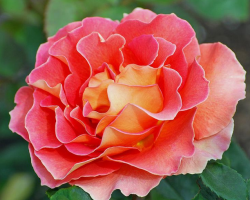To obtain a good harvest, it is important to carry out the formation of Bulgarian pepper. Read more in the article.
Content
- Bulgarian pepper varieties: Features of their formation
- When to start the formation of Bulgarian pepper?
- Rules for the formation of Bulgarian pepper
- Ways to form Bulgarian pepper
- Stages of the formation of Bulgarian pepper: Scheme
- Greenhouse stepson of Bulgarian pepper: Principle
- Do I need to cut pepper?
- Errors in the formation and cultivation of Bulgarian pepper
- Pests of Bulgarian pepper
- Proper care for pepper after forming
- Video: How to form pepper?
- Video: Formation of pepper to increase the crop!
- Video: Sweet pepper - pinch or not?
According to experienced summer residents, the process of plant formation is the main way to increase the yield and size of future fruits. Beginning vegetable growers rarely use this technique, believing that the plant will give a good harvest without the formation procedure, and that it is possible to do only watering and top dressing. However, formation is not a single procedure associated with circumcision and pinching. This process has a large number of stages and includes many techniques.
Read on our website another article on the topic: "What can be made from Bulgarian pepper for the winter?". You will find recipes for blanks of sweet Bulgarian pepper for the winter. You will also find advice about drying, freezing, pickling. Even in this article there are the best recipes for cooking stuffed with vegetables, fried Bulgarian pepper, in tomato-garlic filling, caviar, lecho, adzhiki from Bulgarian pepper for the winter.
A bush of pepper, formed according to all the rules, will have a beautiful look and will be able to please the vegetable breeder with a good harvest. How to do this correctly, read on.
Bulgarian pepper varieties: Features of their formation

Starting to the formation of Bulgarian pepper should take into account the features of each variety. Here are their list and features of their formation:
- Tall pepper: When forming, it is necessary to carry out a pinching procedure, as well as cut off the shoots that are superfluous and which interfere with growth.
- Medium -sized pepper: It is important to remove barren side shoots. This will increase the supply of light, and the air will circulate around plants more well.
- Low -growing and dwarf peppers: These species do not require special formation. When growing them, it will be enough to remove weak shoots without fruits.
The pinching of culture should be performed very carefully. Follow all the rules.
When to start the formation of Bulgarian pepper?
The procedure for the formation of Bulgarian pepper should begin immediately after the appearance of the first fork. If you wait, when the low pepper grows up to 25 cm - As some summer residents advise, then in the future, instead of fruits, you can collect pods.
Before the start of the formation, pepper is transferred to greenhouse conditions, or open soil, when the culture takes root, new leaves will begin to appear on it.
Rules for the formation of Bulgarian pepper
In order to collect the rich harvest of Bulgarian pepper in the future, you need to know the rules of formation:
- Low -growing varieties should be able for free growth.
- There should be few ovaries, then the size of the pods will increase.
- Thanks to the pinch, the ripening rate increases.
- Do not leave stepsons before the process of cimming the first fork.
- Remove all shoots directed inside the bush.
- When forming a bush, it is worth leaving 2-3 barrels.
- Frame shoots should grow freely.
- Blinded twigs above the ovaries should have 1-2 sheets to receive food.
- Tall varieties must be tied (each escape separately).
- The fruits on the frame branches need to be distributed evenly.
Processes should be removed when it is possible to do this without injuring the bush itself.
Ways to form Bulgarian pepper
There are several different ways to form Bulgarian pepper:
- Removing inflorescences: growing up up to 20-25 cm, the skeletal stem begins to branch. Budons grow in the field of bifurcation. They must be removed, for a further, correct branching process.
- Pinching of processes: The correct bush should have a stem and a couple of strong shoots coming from the inflorescence. Other branches should be removed by trimming.
- In one stem: When the bushes are located at a small distance from each other, cultures are able to unite in one stem. In such a situation, there will be no way to harvest from large bushes, so they must be discharged to improve the ventilation and nutrition of each of the plants.
If the first two methods are clear, you need to remove the buds or pinch the processes. Then the process of formation " in one stem"Not always understandable, especially to beginner gardeners. It looks as follows:
- The first stage should begin in case of branches.
- All growing shoots are pinned, you need to save only the main stalk on which the ovary is located.
- Fresh forces appearing on a skeletal stem should also be removed.
- After ripening on the bush, 12 fruits, pinch the crown.

There are 1 more method - "In two stems."This is the most common form of formation. As a result, the plant should have V-shaped design. This method allows you to collect about 25 fruits from the 1st plant. The process has the following sequence:
- The first -order skeleton shoots grow on 2 processes second order. The strongest escape is left untouched. He will support other processes that are above and be considered skeletal. On this process, leave buds with leaves. The second process is usually weaker. Pinch it, keeping the fruits with the leaves.
- The main escape of the second order is divided into two processes that will have the third order. From these branches it is also necessary to highlight the skeletal process. It will develop well and grow well. In the sinuses of the leaves of the main process, remove all the stepson. In addition, all yellowed leaves should be removed from the main branches. Pin the weakest process of the third order at the top, where the flower bud is located. It is necessary to leave one sheet that will feed all the ovaries.
- A similar process is carried out with a skeletal process of the first order of the second branch (1st fork). The bush is divided into two stems. If you keep two side shoots on the stem instead of one, then the main branches will turn out 4. One must be cut.
- After ripening on the bush 20-26 fruits, Cut the tops of the plant.
- After cutting the top, the nutrients will redirect to young ovaries.
Another popular way of formation "Three stems":
- To grow pepper in three stems, you need to have a large greenhouse, but this method will bring the richest crop.
- With this option, each bush receives maximum nutrition and lighting.
Choose the most suitable method for yourself. The stages of formation are described below. Read further.
Stages of the formation of Bulgarian pepper: Scheme
When forming a plant with a stem method, you need to install trellises, so that the branches of all orders are attached to transverse mounts. Here's a scheme:

Remember: A large number of fruits can break thin branches.
Low -growing, hybrid and slightly weak varieties are not required.
It is worth knowing:
- Perform processing during the appearance of the first branches.
- In cases where the number of sprouts that appeared is more than 3Excessive are removed.
- If the number of sprouts by branching less than 3, then you need to leave the lower processes on the skeletal stem. When they grow up, leave the strongest, removing the rest.
- After the appearance of the fork on the stems of the first order, all weakened, thin processes are cut and one is left, more strong.
- The cut should be repeated for the main branches of new orders before the time until it grows on one bush from 25 to 30 fruits.
- Then cut the top of the plant in order to remove the growth point. This will give the bush the opportunity to form a rich harvest.
On the main stems of all orders, new leaves and ovaries may soon appear. They must be gradually cut off. First, those leaves that shade the ovaries should be removed. This procedure should be repeated until the bush grows up to one meter high. So that there is no more growth, and the beneficial substances headed to the lower fruits and ovaries, the top is cut. In 1.5 months. Before the collection of fruits, in the main branches of all orders, it is necessary to cut the top in order for useful trace elements to redirect to the lower fruits.
It is worth knowing: On the formed plants of plants, they usually retain about 20-25 large thick -walled fruit. With the onset of autumn, on non -formed bushes, a large number of small ovaries and fruits will appear.
Remember:
- With the growth of pepper in the garden - in the open air, and not in greenhouse conditions, only tall varieties need to be formed.
- The medium -sized form needs to be removed only fruitless shoots with stepsons, to provide bushes with a sufficient amount of oxygen and light.
- The low -growing look is not necessary to process.
Important: The removal procedure is subject to all growing inside, broken and crooked processes. The bushes of medium -sized and stunted pepper need to pinch the central processes to enhance the lateral branching.
Stages of the formation of Bulgarian pepper - sequence:
- As soon as the pepper strongly and reaches height 25-30 cm, it is necessary to remove all primary buds.
- In addition, cut the kidneys on lateral shoots, this will give an impetus to the growth of additional branches. Seedlings will swear.
- All the following shoots should be formed in the same way: remove the stems and leave 3-5 twigs.
- On the skeletal process, before the first fork, remove the shoots and sheets.
- All main trunks should be cut at the growth site, after the appearance of a large number of fruits.
- Perform the final cutting procedure a few weeks before the end of the fruiting.
The total number of fruitful processes should not be more than 4-6 pieces,and fruits 15-25 pieces.
Greenhouse stepson of Bulgarian pepper: Principle
Bringing seedlings into a greenhouse, it must be planted in such a way that there is always a space to increase the volume by several bushes. The landing scheme of the most bushy species can be 5-6 pieces per square meter. With medium bush, they plant 6-8 bushes One meter.

The principle of greenhouse formation of Bulgarian pepper is to get rid of plants from barren processes:
- After taking care of the plant at the place of landing, it must be constantly inspected and processed from parasites.
- Fire processes growing on the stem before the first fork should be removed to provide the bushes of good lighting and air circulation.

Pepper shoots that appeared after branching are called lateral. These processes are skeletal. Each of these processes initially grows in the form of a central stem with leaves. Subsequently, new processes will begin to appear in the sinuses of the leaves, which are called stepsons. These processes must be removed by pinching.
Do I need to cut pepper?
Pepper pruning is a necessary process in order for the beneficial resources of the plant to the formation and maturation of fruits, and not green mass. Cutting the pepper must be observed. You can not cut the bush too strongly, because such a plant cannot give a large harvest of fruit. Removing unnecessary shoots and greenery should occur rationally.
Errors in the formation and cultivation of Bulgarian pepper
The formation of a bush of Bulgarian pepper actually begins with the planting process. The gardener should not only know how to cut or pinch the bush, but also how to plant, fertilize and water the plants. Here are errors in the formation and cultivation of Bulgarian pepper:
- Violation of the terms of landing: Pepper seedlings need to be planted only after the threat of the return of spring frosts disappears, otherwise, the plant may die. According to experienced vegetable growers, in the middle lane, seedlings begin to be planted in open ground in late May - early June. You can plant seedlings in closed structures at the end of April, and in greenhouses with heating - in mid -March.
- Excessive nutrition fertilizers: At the beginning of the growing season, like other petty cultures, pepper needs nitrogen top dressing. However, do not overdo it with fertilizers, because overfeeding leads to excess formation of useless, green mass. Water seedlings once, after rooting. As a fertilizer, you can use a weak solution of carbamide (one dessert spoon per 10 liters of water) or a weak solution of dung slide (1:10).
- Violation of the temperature regime: If the bushes have many peduncles, but the ovaries do not form at all, then the plant experiences problems with pollination. This can occur due to increased humidity, for example, in a greenhouse, as well as sharp temperature fluctuations. The heat and cold are equally harmful to plants. It is necessary to reduce watering, constantly ventilate closed structures during the heat and heat during cooling. It is necessary to treat seedlings with drugs that improve the appearance of ovaries.
- Incorrect watering: both the deficiency and excess water in the soil are harmful. When watering with ice water or drying the soil, they begin to massively fall into the ovaries and flowers. Water plants with defended water, heated once every 3-7 days, when 2-3 cm of the top layer of soil dries.
- Malnutrition: disadvantage of minerals, such as calcium, magnesium and potassium in combination with cooling, can lead to the formation of fruit rot. Ripening fruits, on sick plants, begin to rot at the site of fastening of the stalk. During the cold summer, you need to use foliar top dressing with the addition of phosphorus-potassium fertilizers.
- Cross pollination of sweet and sharp varieties, when they are in one greenhouse.
- Long exposure of seeds in potassium permanganate: This substance well removes all harmful microorganisms from this material. However, too strong the solution and too long exposure of the seeds can lead to combustion of the material.
Experienced vegetable growers advise using a solution of no more than a 0.5 percent fortress and keep the seeds in it for no longer than 25 minutes. To prepare such a solution, it is necessary to dilute 0.5 teaspoon of manganese in 600 milliliters of water.
Pests of Bulgarian pepper

Dangerous pests for Bulgarian pepper are whiteflies, thrips, a larva of the May beetle. Greenhouse plants are most often attacked by aphids. Fertening and the introduction of potassium-phosphorus fertilizers into the soil are very good in the fight against pests. In addition, drugs created on the basis of rapidly decomposed, biological toxins or viruses that kill parasites give a good effect. For humans and plants, such substances are safe. Spraying crops to get rid of pests is best carried out exclusively in the morning hours.
- Bulgarian pepper is a very smart culture.
- Therefore, carefully watching it, you can quickly understand that the plant is sick.
- The main signs of the disease are: a change in color and yellowness of leaves, fading.
- Timely reaction and subsequent care of the plant will allow it to quickly recover and continue to bear fruit.
During flowering and budding, it is necessary to make vegetable ash, in the amount of 1-2 glasses per linear meter (before watering). You can additionally treat plants with drugs that increase stress resistance and immunity, for example: zircon, ecoberin, force. This procedure should be performed in the morning, preparing the solution in advance, following the instructions on the package.
Proper care for pepper after forming

Formation is a serious stress for the plant due to the fact that many leaves and processes are removed from it. After this process, the plant requires high -quality and proper care, to restore and continue growth:
- First of all, pepper must be tied to the support so that its branches do not break under the weight of the fruits.
- Constantly spray the culture with warm water.
- Do watering in the early morning, or late in the evening.
- The following irrigation must be combined with the process of fertilizer.
Following the advice and recommendations of experienced summer residents, we can avoid the most common mistakes when growing bell pepper. Good luck!
Video: How to form pepper?
Video: Formation of pepper to increase the crop!
Video: Sweet pepper - pinch or not?
Read on the topic:
- When you need to start feeding pepper seedlings: top dressing schedule
- How to distinguish seedlings of bitter pepper from sweets by external signs
- How to feed the seedlings of tomato and pepper so that there are thick ones?
- Planting and growing seedlings of Bulgarian pepper at home
- Peppers seedlings: diseases and pests








A wonderful site, thanks, I would like to have a subscription, but I did not find how to do it.